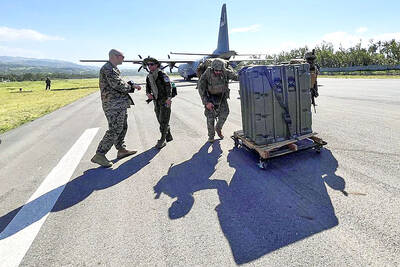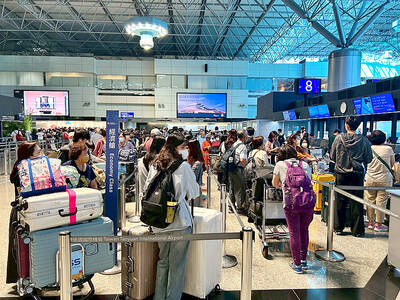Ministry of Transportation and Communications figures show that the number of motor vehicles in the country exceeded 20 million for the first time last May, a number possibly including more than 3 million abandoned "ghost scooters" nationwide.
The ministry estimated that the total number of vehicles on the nation's roads likely reached 20.3 million at the end of last year. Scooters and motorcycles comprise approximately two-thirds of the nation's vehicles.
The three areas with the most vehicles are Taipei County, Taipei City and Kaohsiung City -- in that order -- which together account for about one-third of all Taiwanese vehicles, statistics showed.
Taiwan also has a surprising number of issued driver's licenses, with the ministry estimating there are 22.8 million registered drivers nationwide. Officials said this was possible because of a growing trend of people carrying multiple licenses.
Ghost vehicles are a growing problem. Based on vehicle use surveys from 2005, the ministry now estimates that only about 11.1 million of more than 13 million scooters nationwide are in use.
The number of ghost scooters -- most of which have been stolen or abandoned -- is difficult to ascertain because it has been more than 12 years since Taiwan required all vehicles to switch to new license plates.
When Taiwan switched license plates in 1995, the owners of only about 65 percent, or less than 8 million, of the more than 12 million registered scooters at that time applied for new plates, indicating that the remaining vehicles were no longer being used.
Based on this experience, officials say that as many as 3 million to 4 million of the current registrations may be for scooters that are no longer used. The actual number will only be known after new anti-counterfeiting license plates are issued next year.
Ministry officials warn that owners may be fined for abandoning a scooter or motorcycle rather than filing the appropriate paperwork.

Three batches of banana sauce imported from the Philippines were intercepted at the border after they were found to contain the banned industrial dye Orange G, the Food and Drug Administration (FDA) said yesterday. From today through Sept. 2 next year, all seasoning sauces from the Philippines are to be subject to the FDA’s strictest border inspection, meaning 100 percent testing for illegal dyes before entry is allowed, it said in a statement. Orange G is an industrial coloring agent that is not permitted for food use in Taiwan or internationally, said Cheng Wei-chih (鄭維智), head of the FDA’s Northern Center for

The Chinese military has built landing bridge ships designed to expand its amphibious options for a potential assault on Taiwan, but their combat effectiveness is limited due to their high vulnerability, a defense expert said in an analysis published on Monday. Shen Ming-shih (沈明室), a research fellow at the Institute for National Defense and Security Research, said that the deployment of such vessels as part of the Chinese People’s Liberation Army (PLA) Navy’s East Sea Fleet signals a strong focus on Taiwan. However, the ships are highly vulnerable to precision strikes, which means they could be destroyed before they achieve their intended

LOOKING NORTH: The base would enhance the military’s awareness of activities in the Bashi Channel, which China Coast Guard ships have been frequenting, an expert said The Philippine Navy on Thursday last week inaugurated a forward operating base in the country’s northern most province of Batanes, which at 185km from Taiwan would be strategically important in a military conflict in the Taiwan Strait. The Philippine Daily Inquirer quoted Northern Luzon Command Commander Lieutenant General Fernyl Buca as saying that the base in Mahatao would bolster the country’s northern defenses and response capabilities. The base is also a response to the “irregular presence this month of armed” of China Coast Guard vessels frequenting the Bashi Channel in the Luzon Strait just south of Taiwan, the paper reported, citing a

About 4.2 million tourist arrivals were recorded in the first half of this year, a 10 percent increase from the same period last year, the Tourism Administration said yesterday. The growth continues to be consistent, with the fourth quarter of this year expected to be the peak in Taiwan, the agency said, adding that it plans to promote Taiwan overseas via partnerships and major events. From January to June, 9.14 million international departures were recorded from Taiwan, an 11 percent increase from the same period last year, with 3.3 million headed for Japan, 1.52 million for China and 832,962 to South Korea,